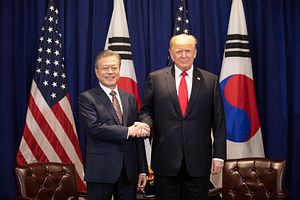This week, South Korea and the United States finalized revisions to the United States-Korea Free Trade Agreement (known as KORUS), which governs trade interactions between them. Although U.S. President Donald Trump was quick to tout the new deal as a success and “very, very good for American farmers,” a closer examination shows not much has changed. Even among the modifications, U.S. companies didn’t gain much.
At this time last year, South Koreans were quite nervous about the prospects of Trump terminating KORUS wholesale. With the United States accounting for 14 percent of all Korean exports (valued at $70 billion), many Korean companies were worried tariffs would gash their bottom line. After a year of patient negotiation, however, it is safe to say bandages won’t be needed.
The main modifications to KORUS involved automobiles. U.S. tariffs on South Korean-made trucks, which were scheduled to be phased out by 2021, were extended by 20 years. This is a concession many American automakers had long wanted, as most now depend on domestic truck sales for survival. Despite the current hegemony of trucks made by U.S. companies, foreign brands, including Hyundai, have slowly increased their market share. So, on the face of it, this looks like a win for U.S. companies.
Digging deeper, however, it becomes apparent U.S. brands are unlikely to benefit much. This is because most of the trucks made by foreign companies are already being made in the United States and, therefore, are not exports. With Hyundai also in the process of building more trucks in the United States, the extension of tariffs against Korean-made vehicles is unlikely to have much of a long-term effect. If anything, the only losers will be South Korean workers, who will see even more of their jobs moved abroad.
Another KORUS modification was South Korea’s agreement to admit twice as many U.S. cars that meet only U.S. safety and emission standards but not the more stringent Korean standards. The number of exceptions was increased from 25,000 to 50,000. South Korea also agreed to recognize U.S. standards for auto parts used in servicing. In short, this package of changes makes it easier for U.S. cars to enter the Korean market. Another U.S. win, right? Well, not really.
Last year, U.S.-made cars only accounted for 42,000 of the 1.5 million or so new cars registered in South Korea. Among these, two-thirds were actually cars made by German or Japanese companies, albeit in U.S. factories. Put simply, South Koreans aren’t that interested in American cars. Whereas German brands such as BMW and Mercedes-Benz command respect and have social value, Chevy and Ford simply don’t. In light of this, the KORUS modifications are much more likely to benefit German brands than American ones.
Although Trump specifically said KORUS revisions were good for U.S. farmers, this is misleading. The only new provision potentially applying to agriculture is the establishment of a working group to monitor South Korean customs procedures, which have already become very transparent in recent years. Previous versions of KORUS, have, of course, been exceptional for U.S. agriculture, but the new agreement simply doesn’t add anything other than continued optimism. If anything, continuation of the old implements will likely persist in hurting domestic consumption of South Korean agricultural goods, which have lost about $1 billion worth of market share over the last five years.
Other areas of revision were pharmaceuticals and steel. Here too, South Korea gave concessions, allowing American pharmaceuticals to be more competitive on the Korean market while also agreeing to reduce, by 30 percent, the number of steel products exported to the United States. Since South Korea already has a strong domestic drug manufacturing base, the pharmaceutical concession seems unlikely to have serious effects. The steel concession also has done little to harm the earnings of POSCO and other Korean manufacturers, who have already pre-emptively redirected many of their exports to India.
So how does North Korea come out disappointed? There was originally much speculation that President Moon Jae-in might offer the United States extra concessions if they would be willing to participate more actively in a trilateral peace deal. Given that Trump’s recent statements about North Korea at the UN were well in line with rhetoric prior to signing KORUS revisions, it appears Moon was unable to forge a comprehensive deal. The new agreement does relieve leverage Washington was using against Seoul but, as others have pointed out, there is no provision in the new deal saying Section 232 has been satisfied, meaning the Trump administration can easily revisit the issue at a later date if they so choose.
Justin Fendos is a professor at Dongseo University (South Korea) and the associate director of the Tan School at Fudan University (Shanghai).































